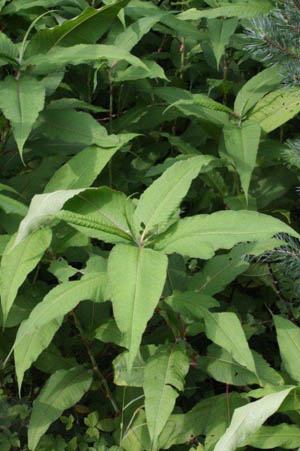1. Rubrivena polystachya (Wall. ex Meissner) M. Král (syn.: Persicaria wallichii Greuter et Burdet, P. polystachya (Wall. ex Meissner) H. Gross, Polygonum polystachyum Wall. ex Meissner, Aconogonum polystachyum (Wall. ex Meissner) Small) (Himalayas) – A rather rare, locally naturalized garden escape. First recorded in 1898 in Oostende. Subsequently collected in numerous locations throughout Belgium and well-established in several places: locally abundantly naturalized in the Kempen (Mol, at least since 1974 and Rijkevorsel, since 1995,…). Sometimes very persistent and probably naturalized elsewhere (Mirwart, Wijnegem, Petite-Chapelle,…). Usually found on canal- or river banks, road verges, sometimes in wasteland or as a relic of cultivation near houses.
Rubrivena polystachya is very distinctive in having a panicle-like inflorescence, a character shared with representatives of the genus Aconogonum. Several species of this genus are cultivated for ornament (rarely also in Belgium, at least Aconogonum weyrichii (F. Schmidt ex Maxim.) H. Hara (syn.: Persicaria weyrichii (F. Schmidt ex Maxim.) Ronse Decraene) and might be confused with Rubrivena polystachya (see Karlsson 2000, Stace 2010). However, in Rubrivena polystachya leaves are sparsely strigose beneath (at least on veins and near margins), whereas in Aconogonum leaves are either perfectly glabrous or hairy throughout.
|
|
|
|
|
Selected literature:
Adolphi K. (1995) Neophytische Kultur- und Anbaupflanzen des Rheinlandes. Nardus 2: 1-271.
Bartoszek W., Urbisz A., Tokarska-Guzik B. (2006) Polygonum polystachyum Wall. ex Meissner in Poland: status, distribution, habitats. Biodiv. Res. Conserv. 1-2: 86-88 (available online at: http://www.brc.amu.edu.pl/s2_c1.html).
Brandes D. (1989) Hinweis auf Verwilderung von Polygonum polystachyum Wall. e Meisn. Flor. Rundbr. 23(1): 50-51.
Conolly A.P. (1977) The distribution and history in the British Isles of some alien species of Polygonum and Reynoutria. Watsonia 11: 291-311.
Conolly A.P. (1991) Polygonum lichiangense W. Smith rejected as a naturalized British species. Watsonia 18: 351-358.
Diekjobst H. (1992) Der Vielähige Knöterich (Polygonum polystachyum) im Iserlohner Stadtwald (Sauerland). Natur und Heimat 52(2): 49-54.
Karlsson T. (2000) Polygonaceae. In: Jonsell B. (ed.), Flora Nordica, vol. 1. The Bergius Foundation, Stockholm: 235-318.
Stace C. (2010) New flora of the British Isles, 3th ed.: XXXII + 1232 p. Cambridge University Press.
Verloove F. (2002) Ingeburgerde plantensoorten in Vlaanderen. Mededeling van het Instituut voor Natuurbehoud n° 20: 227 p.


